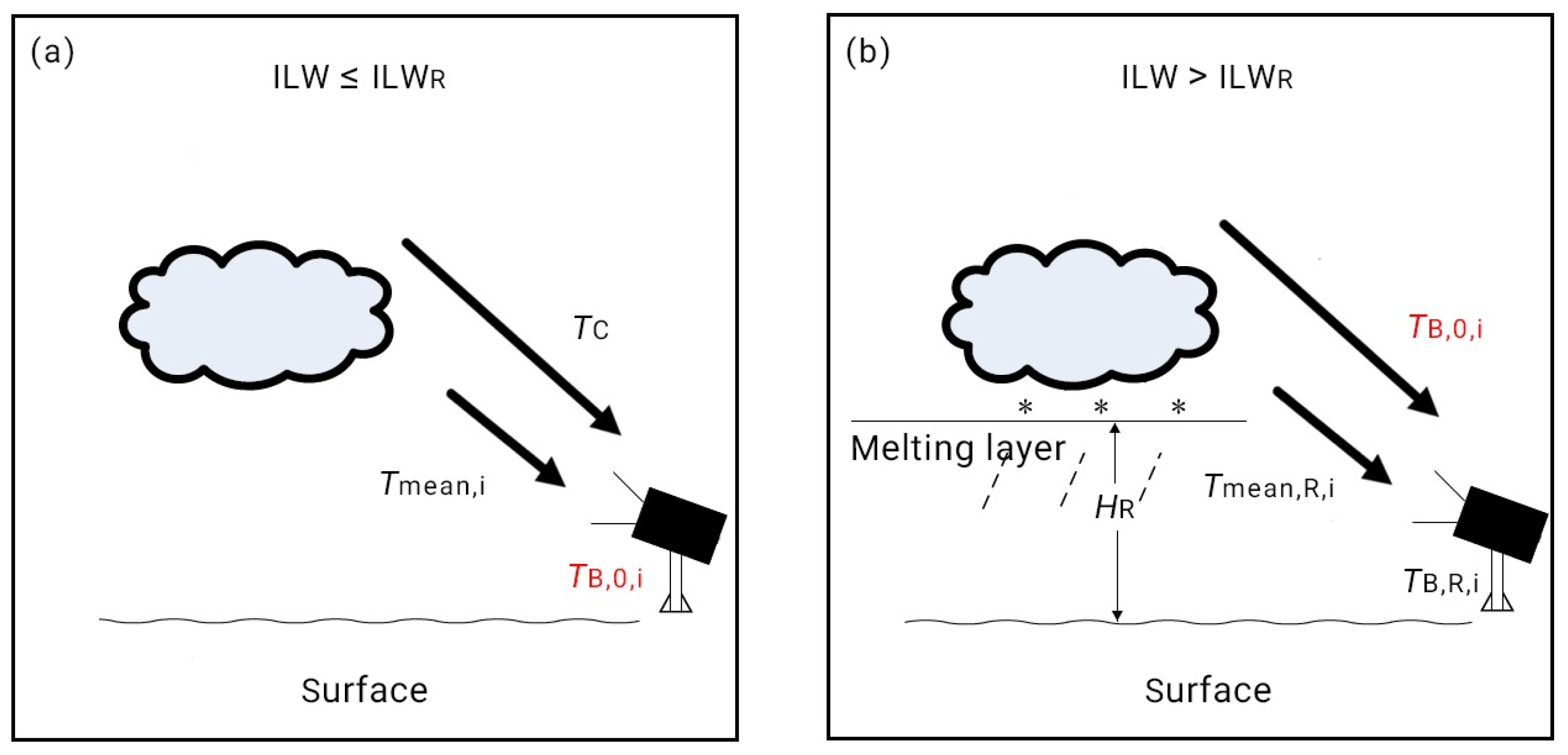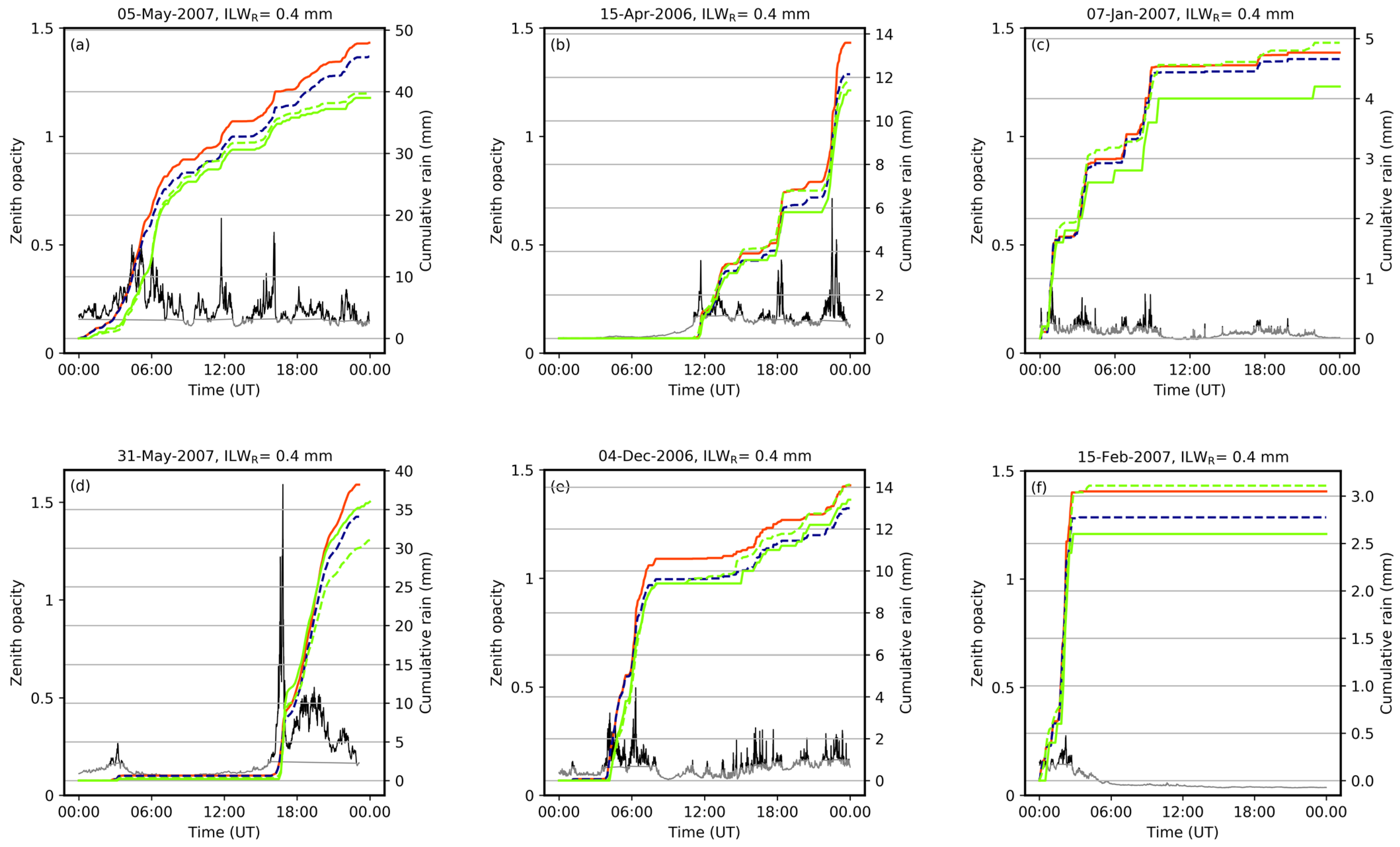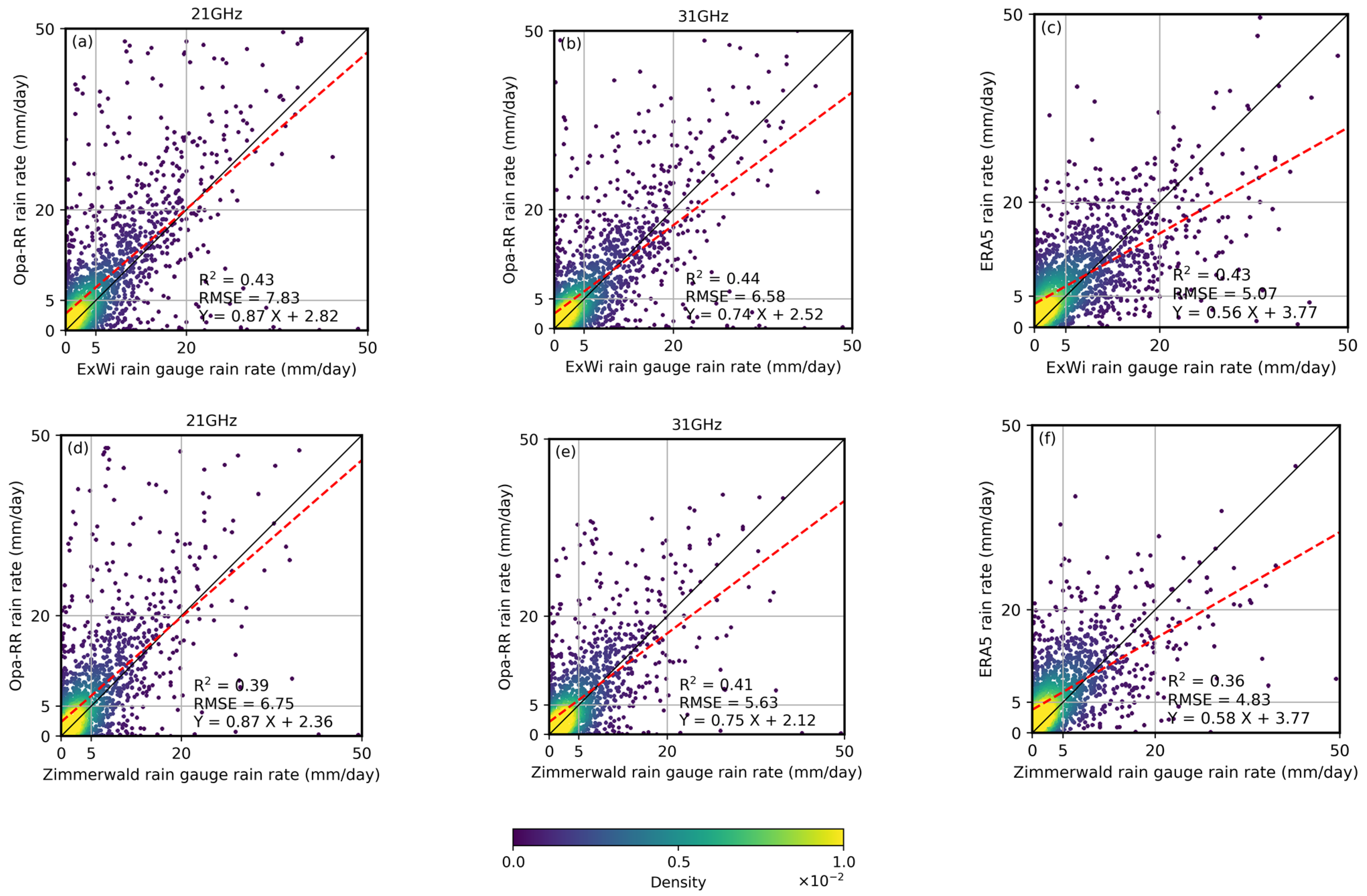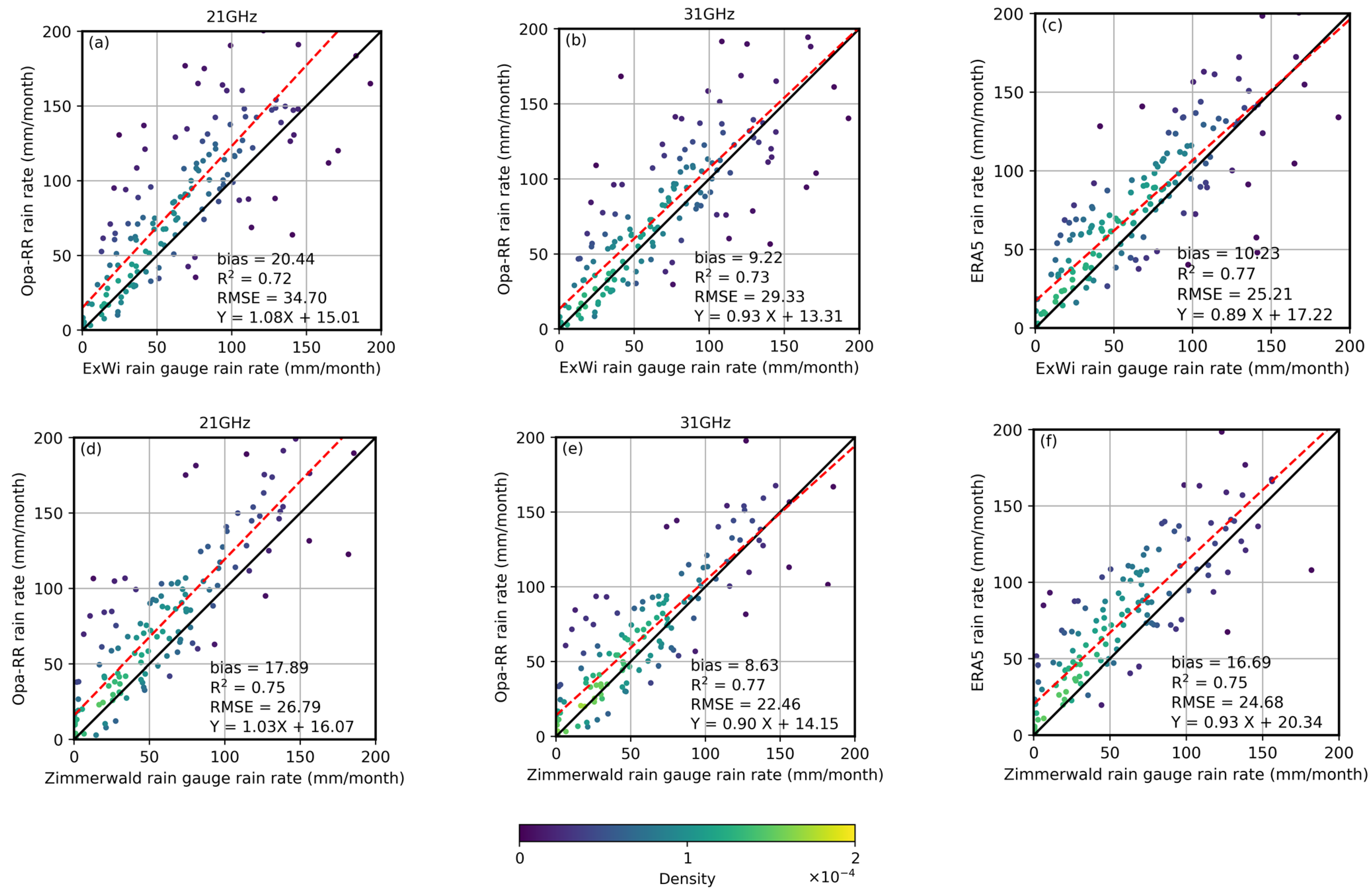Physical Retrieval of Rain Rate from Ground-Based Microwave Radiometry
Abstract
1. Introduction
2. Data Set
2.1. Ground-Based Microwave Radiometer Data
2.2. Meteorological Data
2.3. Rain-Rate Measurements
2.4. ERA5 Reanalysis Data
3. Methods
3.1. Physical Retrieval Method Opa-RR for Rain-Rate Estimation
3.1.1. Effective Zenith Opacity and Specific Rain Absorption
3.1.2. Rain Zenith Opacity from TROWARA
3.2. Data Processing
- Step1: rain-day events detected by TROWARA;
- Step2: rain-day events detected by the rain gauge (ExWi or Zimmerwald rain gauge);
- Step3: simultaneous and available rain-day events at Step 1 and Step 2;
- Step4: the data of TROWARA, the rain gauge, and ERA5 all follow rain-day events of Step 3.
4. Results
4.1. Daily Rain-Rate Estimation
4.2. Monthly Rain-Rate Estimation
4.3. Annual Rain-Rate Estimation
5. Conclusions
Author Contributions
Funding
Data Availability Statement
Acknowledgments
Conflicts of Interest
References
- Orlandi, A.; Ortolani, A.; Meneguzzo, F.; Levizzani, V.; Torricella, F.; Turk, F.J. Rainfall assimilation in RAMS by means of the Kuo parameterisation inversion: Method and preliminary results. J. Hydrol. 2004, 288, 20–35. [Google Scholar] [CrossRef]
- Wang, J.; Xu, Y.; Yang, L.; Wang, Q.; Yuan, J.; Wang, Y. Data assimilation of high-resolution satellite rainfall product improves rainfall simulation associated with landfalling tropical cyclones in the Yangtze river Delta. Remote Sens. 2020, 12, 276. [Google Scholar] [CrossRef]
- Marzano, F.S.; Fionda, E.; Ciotti, P.; Martellucci, A. Ground-based multifrequency microwave radiometry for rainfall remote sensing. IEEE Trans. Geosci. Remote Sens. 2002, 40, 742–759. [Google Scholar] [CrossRef]
- Cadeddu, M.P.; Ghate, V.P.; Mech, M. Ground-based observations of cloud and drizzle liquid water path in stratocumulus clouds. Atmos. Meas. Tech. 2020, 13, 1485–1499. [Google Scholar] [CrossRef]
- Cadeddu, M.P.; Marchand, R.; Orlandi, E.; Turner, D.D.; Mech, M. Microwave passive ground-based retrievals of cloud and rain liquid water path in drizzling clouds: Challenges and possibilities. IEEE Trans. Geosci. Remote Sens. 2017, 55, 6468–6481. [Google Scholar] [CrossRef]
- Battaglia, A.; Saavedra, P.; Rose, T.; Simmer, C. Characterization of precipitating clouds by ground-based measurements with the triple-frequency polarized microwave radiometer ADMIRARI. J. Appl. Meteorol. Climatol. 2010, 49, 394–414. [Google Scholar] [CrossRef]
- Marzano, F.S.; Cimini, D.; Ware, R. Monitoring of rainfall by ground-based passive microwave systems: Models, measurements and applications. Adv. Geosci. 2005, 2, 259–265. [Google Scholar] [CrossRef][Green Version]
- Won, H.Y.; Kim, Y.-H.; Lee, H.-S. An application of brightness temperature received from a ground-based microwave radiometer to estimation of precipitation occurrences and rainfall Intensity. Asia-Pac. J. Atmos. Sci. 2009, 45, 55–69. [Google Scholar]
- Xu, G.; Ware, R.; Zhang, W.; Feng, G.; Liao, K.; Liu, Y. Effect of off-zenith observations on reducing the impact of precipitation on ground-based microwave radiometer measurement accuracy. Atmos. Res. 2014, 140–141, 85–94. [Google Scholar] [CrossRef]
- Mätzler, C.; Morland, J. Advances in Surface-Based Radiometry of Atmospheric Water; IAP Research Report 2008-02-MW; Institut für Angewandte Physik, Universität Bern: Bern, Switzerland, 2014. [Google Scholar]
- Hocke, K.; Navas-Guzmán, F.; Moreira, L.; Bernet, L.; Mätzler, C. Diurnal cycle in atmospheric water over switzerland. Remote Sens. 2017, 9, 909. [Google Scholar] [CrossRef]
- Hocke, K.; Bernet, L.A.L.; Hagen, J.; Murk, A.; Renker, M.; Mätzler, C. Diurnal cycle of short-term fluctuations of integrated water vapour above Switzerland. Atmos. Chem. Phys. 2019, 19, 12083–12090. [Google Scholar] [CrossRef]
- Ingold, T.; Peter, R.; Kämpfer, N. Weighted mean tropospheric temperature and transmittance determination at millimeter-wave frequencies for ground-based applications. Radio Sci. 1998, 33, 905–918. [Google Scholar] [CrossRef]
- Mätzler, C.; Morland, J. Refined physical retrieval of integrated water vapor and cloud liquid for microwave radiometer data. IEEE Trans. Geosci. Remote Sens. 2009, 47, 1585–1594. [Google Scholar] [CrossRef]
- Ellison, W. Dielectric properties of natural media. In Thermal Microwave Radiation: Applications for Remote Sensing; Mätzler, C., Ed.; IET Electromagnetic Waves Series: London, UK, 2006; Volume 52, pp. 431–454. [Google Scholar]
- Peter, R.; Kämpfer, N. Radiometric determination of water vapor and liquid water and its validation with other techniques. J. Geophys. Res. Atmos. 1992, 97, 18173–18183. [Google Scholar] [CrossRef]
- Morland, J. TROWARA–Tropospheric Water Vapour Radiometer: Radiometer Review and New Calibration Model; IAP Research Report 2002-15; Institut für Angewandte Physik, Universität Bern: Bern, Switzerland, 2002. [Google Scholar]
- Marzano, F.S.; Cimini, D.; Ciotti, P.; Ware, R. Modeling and measurement of rainfall by ground-based multispectral microwave radiometry. IEEE Trans. Geosci. Remote Sens. 2005, 43, 1000–1011. [Google Scholar] [CrossRef]
- Rosenkranz, P.W. Water vapor microwave continuum absorption: A comparison of measurements and models. Radio Sci. 1998, 33, 919–928. [Google Scholar] [CrossRef]
- Hwang, S.H.; Kim, K.B.; Han, D. Comparison of methods to estimate areal means of short duration rainfalls in small catchments, using rain gauge and radar data. J. Hydrol. 2020, 588, 125084. [Google Scholar] [CrossRef]
- Yilmaz, K.K.; Hogue, T.S.; Hsu, K.-L.; Sorooshian, S.; Gupta, H.V.; Wagener, T. Intercomparison of rain gauge, radar, and satellite-based precipitation estimates with emphasis on hydrologic forecasting. J. Hydrometeorol. 2005, 6, 497–517. [Google Scholar] [CrossRef]
- Donald Ahrens, C.; Henson, R. Meteorology Today: An Introduction to Weather, Climate and the Environment, 9th ed.; Cengage Learning: Belmont, CA, USA, 2009; pp. 164–181. [Google Scholar]
- Zscheischler, J.; Naveau, P.; Martius, O.; Engelke, S.; Raible, C.C. Evaluating the dependence structure of compound precipitation and wind speed extremes. Earth Syst. Dynam. 2021, 12, 1–16. [Google Scholar] [CrossRef]
- Hersbach, H.; De Rosnay, P.; Bell, B.; Schepers, D.; Simmons, A.; Soci, C.; Abdalla, S.; Balmaseda, A.; Balsamo, G.; Bechtold, P.; et al. Operational Global Reanalysis: Progress, Future Directions and Synergies with NWP, ERA Report Series 27; European Centre for Medium RangeWeather Forecasts: Reading, UK, 2018. [Google Scholar] [CrossRef]
- Hersbach, H.; Bell, B.; Berrisford, P.; Horányi, A.; Sabater, J.M.; Nicolas, J.; Radu, R.; Schepers, D.; Simmons, A.; Soci, C. Global reanalysis: Goodbye ERA-Interim, hello ERA5. ECMWF Newsl. 2019, 159, 17–24. [Google Scholar] [CrossRef]
- Xu, X.; Frey, S.K.; Boluwade, A.; Erler, A.R.; Khader, O.; Lapen, D.R.; Sudicky, E. Evaluation of variability among different precipitation products in the Northern Great Plains. J. Hydrol. Reg. Stud. 2019, 24, 100608. [Google Scholar] [CrossRef]
- Nogueira, M. Inter-comparison of ERA-5, ERA-interim and GPCP rainfall over the last 40 years: Process-based analysis of systematic and random differences. J. Hydrol. 2020, 583, 124632. [Google Scholar] [CrossRef]
- Amjad, M.; Yilmaz, M.T.; Yucel, I.; Yilmaz, K.K. Performance evaluation of satellite- and model-based precipitation products over varying climate and complex topography. J. Hydrol. 2020, 584, 124707. [Google Scholar] [CrossRef]
- Mätzler, C.; Martin, L. Effects of Rain on Propagation, Absorption and Scattering of Microwave Radiation Based on the Dielectric Model of Liebe; IAP Research Report 2002-10-MW; Institut für Angewandte Physik, Universität Bern: Bern, Switzerland, 2002. [Google Scholar]
- Leuenberger, A. Precipitation Measurements with Microwave Sensors. Master’s Thesis, Philosophisch-Naturwissenschaftliche Fakultät, Universität Bern, Bern, Switzerland, 2009. [Google Scholar]
- Mätzler, C.; Melsheimer, C. Radiative transfer and microwave radiometry. In Thermal Microwave Radiation: Applications for Remote Sensing; Mätzler, C., Ed.; IET Electromagnetic Waves Series: London, UK, 2006; Volume 52, pp. 1–23. [Google Scholar]
- Mätzler, C. Ground-based observations of atmospheric radiation at 5, 10, 21, 35, and 94 GHz. Radio Sci. 1992, 27, 403–415. [Google Scholar] [CrossRef]
- Petty, G.W. Physical retrievals of over-ocean rain rate from multichannel microwave imagery. Part I: Theoretical characteristics of normalized polarization and scattering indices. Meteorl. Atmos. Phys. 1994, 54, 79–99. [Google Scholar] [CrossRef]
- Latupapua, H.; Latupapua, A.I.; Wahab, A.; Alaydrus, M. Wireless sensor network design for earthquake’s and landslide’s early warnings. Indones. J. Electr. Eng. Comput. Sci. 2018, 11, 437–445. [Google Scholar] [CrossRef]
- Mätzler, C. Drop-Size Distributions and Mie Computations for Rain; IAP Research Report 2002-16-MW; Institut für Angewandte Physik, Universität Bern: Bern, Switzerland, 2002. [Google Scholar]
- Cossu, F.; Hocke, K.; Martynov, A.; Martius, O.; Mätzler, C. Atmospheric water parameters measured by a ground-based microwave radiometer and compared with the WRF model. Atmos. Sci. Lett. 2015, 16, 465–472. [Google Scholar] [CrossRef]
- Marzano, F.S.; Fionda, E.; Ciotti, P. Neural-network approach to ground-based passive microwave estimation of precipitation intensity and extinction. J. Hydrol. 2006, 328, 121–131. [Google Scholar] [CrossRef]
- Battaglia, A.; Saavedra, P.; Simmer, C.; Rose, T. Rain observations by a multifrequency dual-polarized radiometer. IEEE Geosci. Remote. Sens. Lett. 2009, 6, 354–358. [Google Scholar] [CrossRef]
- Zhang, W.; Xu, G.; Xi, B.; Ren, J.; Wan, X.; Zhou, L.; Cui, C.; Wu, D. Comparative study of cloud liquid water and rain liquid water obtained from microwave radiometer and micro rain radar observations over central China during the monsoon. J. Geophys. Res. Atmos. 2020, 125, e2020JD032456. [Google Scholar] [CrossRef]
- Climate Normals Bern/Zollikofen (Reference Period. 1981−2010); Zurich-Airport; Swiss Federal Office of Metreology and Climatology, MeteoSwiss: Zurich, Switzerland, 2014.








| Rainfall Intensity | Rain Accumulation in a Day (mm) | Number of Rain-Day Events | |
|---|---|---|---|
| ExWi | Zimmerwald | ||
| Light rain | 1030 | 963 | |
| Moderate rain | 610 | 515 | |
| Heavy rain | 105 | 51 | |
| Violent rain | 3 | 0 | |
| Daily Rain Rate | Bias (mm/Day) | |||
|---|---|---|---|---|
| Light Rain | Moderate Rain | Heavy Rain | Total | |
| Opa-RR21 vs. ExWi rain gauge | 2.12 | 2.30 | 0.31 | 1.96 |
| Opa-RR31 vs. ExWi rain gauge | 1.69 | 0.61 | −4.19 | 0.89 |
| ERA5 vs. ExWi rain gauge | 2.64 | 0.04 | −8.78 | 0.98 |
| Opa-RR21 vs. Zimmerwald rain gauge | 1.74 | 1.99 | −2.46 | 1.69 |
| Opa-RR31 vs. Zimmerwald rain gauge | 1.35 | 0.48 | −6.07 | 0.81 |
| ERA5 vs. Zimmerwald rain gauge | 2.72 | 0.56 | −9.82 | 1.57 |
Publisher’s Note: MDPI stays neutral with regard to jurisdictional claims in published maps and institutional affiliations. |
© 2021 by the authors. Licensee MDPI, Basel, Switzerland. This article is an open access article distributed under the terms and conditions of the Creative Commons Attribution (CC BY) license (https://creativecommons.org/licenses/by/4.0/).
Share and Cite
Wang, W.; Hocke, K.; Mätzler, C. Physical Retrieval of Rain Rate from Ground-Based Microwave Radiometry. Remote Sens. 2021, 13, 2217. https://doi.org/10.3390/rs13112217
Wang W, Hocke K, Mätzler C. Physical Retrieval of Rain Rate from Ground-Based Microwave Radiometry. Remote Sensing. 2021; 13(11):2217. https://doi.org/10.3390/rs13112217
Chicago/Turabian StyleWang, Wenyue, Klemens Hocke, and Christian Mätzler. 2021. "Physical Retrieval of Rain Rate from Ground-Based Microwave Radiometry" Remote Sensing 13, no. 11: 2217. https://doi.org/10.3390/rs13112217
APA StyleWang, W., Hocke, K., & Mätzler, C. (2021). Physical Retrieval of Rain Rate from Ground-Based Microwave Radiometry. Remote Sensing, 13(11), 2217. https://doi.org/10.3390/rs13112217







